
4 Ways to Use the A/B Testing Tools in HubSpot (Plus a Bonus Tip)
September 4, 2019
By Kate Uhry
A/B testing is a great way to put marketers in our place. You know your personas. You know marketing best practices. But if you are honest with yourself, you are making assumptions every single day about how your audience will respond to your marketing efforts—what subject line will get them to open an email, what landing page design will get them to fill out a form. Making even educated guesses means that you aren’t basing your decisions on data, and that is a critical point. A/B testing will help you back up your marketing decisions.
HubSpot has some great tools for helping you set up A/B tests, but before I dive into the details, let’s review best practices.
Review: Best Practices for A/B Testing
Know How to A/B Test for Best Results
HubSpot has a great guide to make sure you are using best practices, such as determining your sample size and picking the right variables to test. They also have a short 20-minute lesson called Testing Your Marketing Emails that you can watch on the HubSpot Academy platform.
Go Big or Don’t Bother
A/B testing is pointless if you aren’t testing something that will give you a meaningful result. As my colleague and website CRO expert Kristen Patel points out in her blog on A/B testing, you may need to think big and not just test one small element on a page:
“Personally, I blame the go-to example for A/B testing (Which leads to more clicks: A red button? Or a blue button?) for this having become a common practice. But even though we as marketers can test individual variables like the button color, chances are that this variable won’t have the greatest impact.”
Know the ROI
A/B testing takes time, effort, and in some cases, money. Be sure that you know the cost impact of your testing, as well as the potential cost benefits. HubSpot goes through an example in their guide where they point out that by increasing your conversion rates by leveraging the results of an A/B test, you can offset the time and labor costs of creating that test.
With these best practices in mind, let’s get started on some of the tools you can use.
A/B Testing Tools in HubSpot
There are four main areas where HubSpot allows you to use A/B testing, plus smart content, an extra special tool for content customizations:
- Emails
- CTAs
- Landing pages
- Website pages
Emails
With the launch of the new drag-and-drop email editor for HubSpot Pro and Enterprise users, A/B testing just got super easy. Simply turn on the A/B test button, and you can choose all your settings right there in the editor.
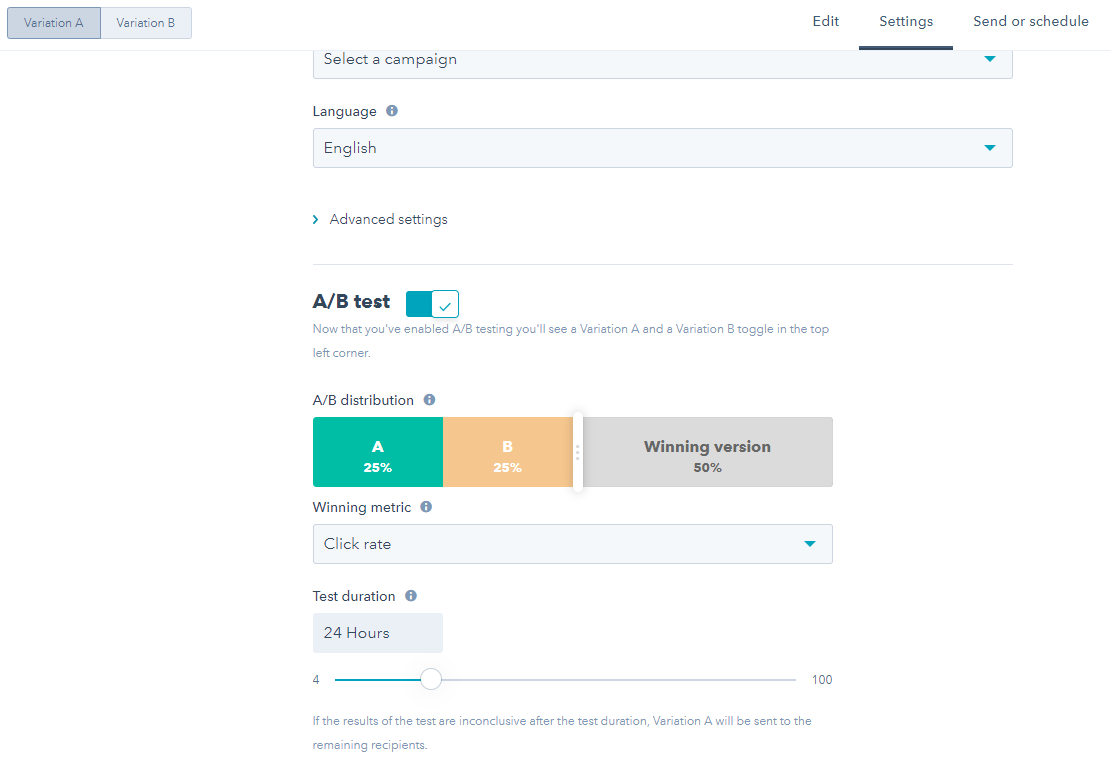
Things to remember:
- For Enterprise users, HubSpot will automatically split traffic to your variations so that you are mailing to a truly random sample.
- You’ll need a list of at least 1,000 recipients to test.
- You can’t A/B test an automated email enrolled in a workflow.
Ideas to try:
- Using the contact name in the subject line
- Sending it from different people or the same person but with two different email sending addresses
- Two different content offers
- Adding an image in the body of the email versus plain text
- Length of the copy (short and sweet versus a little more description)
For specific instructions and descriptions of each of your options, head to this knowledge-base article.
CTAs
I sometimes forget to consider A/B testing on CTAs, because you have to go back after you’ve created the first CTA to add the test. Plus, the options for creating a test can be a little harder to find. Once you’ve created a CTA, go back and click on the “Actions” button to create a variant.
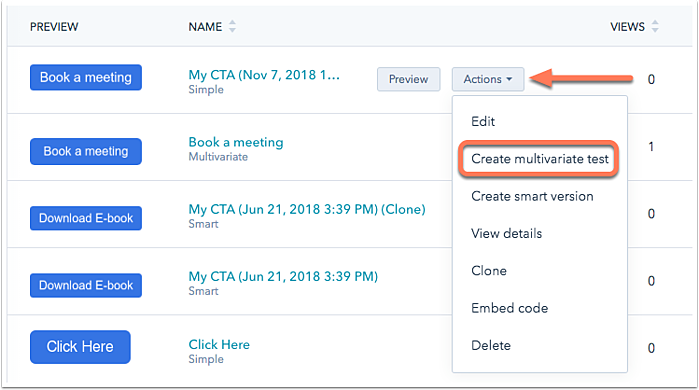
Things to remember:
- You can change multiple things on a CTA test. Although it’s recommended to only change one element, you can decide to do a multivariate test. Here’s how to decide if you should.
- You have the option of creating multiple variations (pink versus blue versus red, and long copy versus short copy) in one test.
- Don’t forget to roll out the winner. Once you have a statistically significant result, a “We have a winner” alert will show up under the details of your test. You’ll want to make sure the winning variant is used going forward if you feel the test has run long enough.
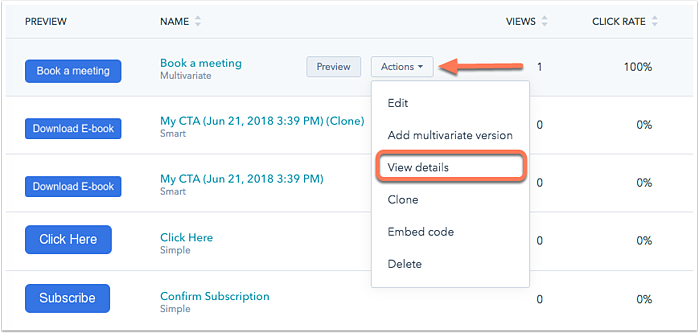

Ideas to try:
- Color (of course, but refer to Kristen P.’s advice—make it significant)
- Size and placement
- Wording (“Book a Meeting” versus “Let’s Chat”)
For specific instructions on how to create CTA tests, head to this knowledge-base article.
Landing Pages
Personally, I think landing pages are the most fun and easiest to test. Unfortunately, you’ll need a HubSpot Professional or Enterprise account in order to play.
Once you’ve created a landing page, go back, drop down on the “More” menu, and create an A/B variant. You’ll end up creating a clone.
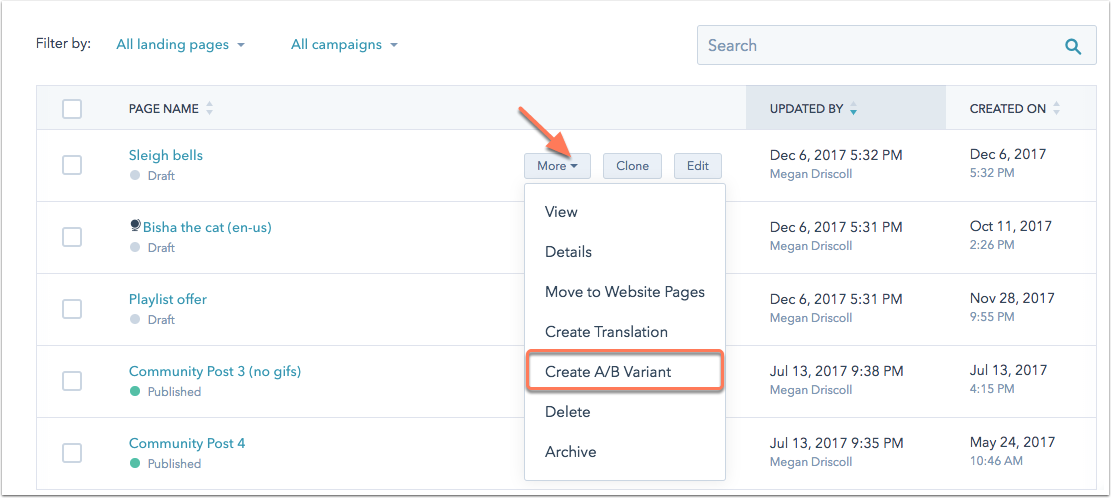
Things to remember:
- Don’t just clone your page and set up a variation manually to assess which one has a higher conversion rate. By using the A/B testing tool, you’ll get more comprehensive statistics and comparison reports.
- You can rerun your test at a later time if you want. This might be helpful to eliminate timing or seasonal factors from your results.
Ideas to try:
- We almost always test forms on landing pages. Is there a specific field (phone, for example) that decreases the number of submissions?
- Banner image
- Offer (which gets people more excited: the e-book or the video version of the same content?)
Here are the instructions for running a test on a landing page.
Website Pages
Last year, HubSpot made it possible to A/B test any webpage using the HubSpot CMS, not just landing pages. It works almost exactly the same way as testing a landing page. Create your website page, drop down the “More” menu, and choose “Create A/B variant.” You’ll see the same types of reporting as well.
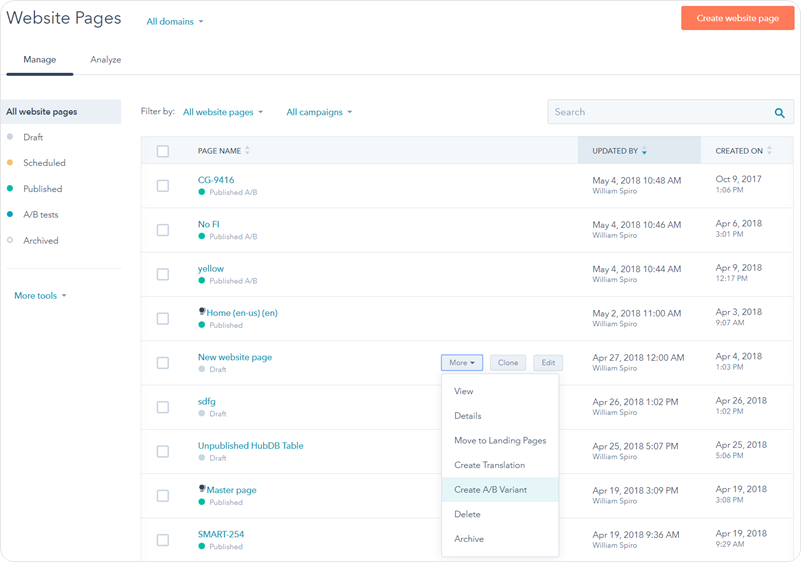
Things to remember:
- Website page tests will show you whether or not someone spends more time on your page.
- Make sure you run the test long enough. If you have a low number of visitors to your site, you may need to wait a few months to be sure you have enough visitors to the page to have a statistically significant outcome. Conversely, if you have a lot of visitors to the page, you might be able to see results within a few weeks.
Ideas to try:
- Contact us page changes, specifically to the form
- Changing the most prominent testimonial
- Headline testing for your personas
- If you are running a paid ad campaign, change which page they land on after clicking on the ad to see which converts better
- Elements like video versus no video for a product page
Here are the instructions on how to create an A/B test on a website page.
Smart Content
This blog wouldn’t be complete without the mention of HubSpot’s option to create smart content. This is dynamic content that is shown on a website page, email, or ad depending on a visitor’s location, language, device type, referral source, or demographic. Although this isn’t an A/B test per se, it is an extremely powerful tool.
A simple example of smart content could be changing the offer on a webpage, based on whether or not someone had already downloaded the content. You could also change up your offer based on what they had purchased before, change the image, or add a personalization field.
Things to remember:
- You need squeaky clean data for this to work well.
- This works best on buyers who know you well. You want to be able to target them with the right offer at the right time.
- This method relies on cookie tracking, which may be unreliable.
Ideas to try:
- Offers (if they liked X, they might also like Y)
- Forms that change based on the device they are on (dropdown choices for mobile users, for example)
- Images based on the location they are coming from
Still Have Questions?
A/B testing is a huge subject, and I know I just scratched the surface here. If you still have questions, HubSpot has a great knowledge base that you can tap into. I also recommend reading 50 Inbound Marketing Resources Every B2B Marketer Should Subscribe to in 2019. Finally, HubSpot is offering an A/B testing kit right now that has a significance calculator and templates to help you track your stats, among other things.

About the author
Kate Uhry was formerly a Marketing Consultant at SmartBug Media. With a rock solid marketing foundation and years of experience, she loves to help customers grow and achieve their business goals. A graduate of Tufts University, with an MBA from the University of Connecticut, Kate is constantly taking a class somewhere. Her idea of happiness is sitting with a good book, a purring cat and a chocolate chip cookie in the sunshine. Read more articles by Kate Uhry.







